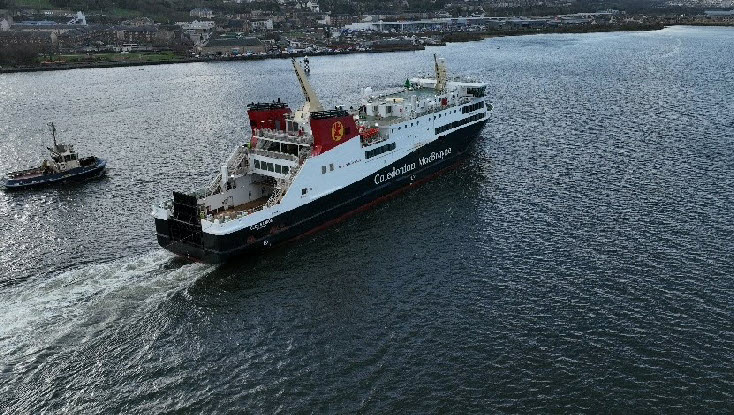CalMac’s newest ferry, MV Glen Sannox has embarked on her longest voyage - and the
ship’s first outside the Clyde area - since being delivered to Caledonian MacBrayne
in mid-November.
The vessel is on sea trials and will test out the piers at a number of Western Isles ports for size.
No trials will take place at Uig due to port authority restrictions but she will
carry out docking tests at the other two Skye triangle harbours as well as on the
Stornoway - Ullapool route.
The vessels appears to have been carrying out endurance tests during today’s sailing to Lewis which saw her operating at higher speeds for longer periods, even touching 18 knots at times. Her service speed is 14.5 knots.
Glen Sannox and her sister vessel, MV Glen Rosa were originally earmarked to operate on several routes across the west coast network and many ferry observers will be keen to judge the outcome of this weekend’s trials. The Glen Rosa was initially designated for the Harris and North Uist service.
MV Glen Sannox will dock in Stornoway number pier overnight and test out the ferry linkspan at number three after MV Loch Seaforth departs after 7am this (Saturday) morning.
The new ship will later head to Lochmaddy and Tarbert.
The Sannox is due to berth at Ullapool tonight (Saturday) though Stornoway is an alternative option.
Following pier trials at Ullapool on Sunday the vessel will head back to the Clyde.
Berthing and sea trials subject to suitable weather and sea conditions and will fit around the CalMac’s operating service ferries vessels at each destination. All vessel movements are subject to change.
Crucial at all port destinations is determining the vessel’s fit with the linkspan. As this is the only way cars and lorries can drive on and off the ship, the ferry’s ramp must be compatible with the infrastructure.
If the Sannox can fit then its highly likely that her sister vessel, MV Glen Rosa
- which was originally designated for the Skye triangle ports of Tarbert, Lochmaddy
and Uig - will also be suitable for the Hebridean piers.
Opening up her engines and testing her machinery and equipment on the lengthy 500 mile round trip provides an excellent “shakedown” voyage test to assess the performance of the ship.
A CalMac spokeswoman said: “Whilst the vessel will operate to Arran, these trials help futureproof the service on multiple routes, as we know where MV Glen Sannox could operate to during periods of disruption.
“We are therefore seeking to conduct these network trials in and around our final operational testing period before the vessel commences service, which would avoid having to remove her from service for these trials if they were required at a later date.”
Calmac is confident of the Sannox commencing commercial sailings with fare-paying
passengers on her Troon - Brodick link from Monday 13 January
At the same time, MV Isle of Arran will be redeployed from Arran to support services in other parts of the CalMac network for the remainder of the winter timetable.
The Sannox will bring additional capacity to Arran, the busiest route on the CalMac network.
However, she is expected to be removed from service for a few days possibly next month to fix an anchor problem.
Ferguson Marine’s interim chief executive officer, John Petticrew, recently told Holyrood’s transport committee one of the ship’s anchors was “slipping” and after being dropped was difficult “to get it back up again.”
New windlass (anchor winch) components arriving in February should provide a “permanent solution” but it will take a “matter of days” to install.
She and her sister will be highly manoeuvrable and more powerful compared to many others in CalMac’s fleet.
MV Glen Sannox is the first vessel in the UK to have a dual-fuel propulsion system
which can use both conventional marine gas oil (MGO) - similar to diesel - or liquefied
natural gas (LNG).
Over recent weeks she has become a familiar sight zipping around the Clyde estuary, testing her steering, acceleration and speed.
Cabinet Secretary for Transport Fiona Hyslop said: “The entry into service of the MV Glen Sannox is very welcome news, as this new vessel will support the people of Arran and wider ferry network.
“She will deliver increased capacity on the busiest route on the Clyde and Hebrides network, and we can all now look forward to her bringing benefits to our island communities and ferry users.
“The MV Glen Sannox is the first of six new major vessels set to serve Scotland’s ferry network, starting in early 2025, underlining the Scottish Government’s commitment to investing in our fleet and delivering the resilient services that our island communities need and deserve. I look forward to sailing on the MV Glen Sannox in the future.”
The Sannox is desperately needed on her designated Arran service which is suffering economic pain following the extremely lengthy withdrawal for major repairs of their main ferry, MV Caledonian Isles.
Past failures to meet target delivery dates due to the gas fuel system were often
highlighted with a code red status under the traffic light colours’ rating adopted
during monitoring of the final stages of ship-build and handover arrangements.
Both the Sannox and her sister ship, MV Glen Rosa, should have been operational in 2018 on CalMac lifeline ferry routes under the original shipbuilding contract between the Scottish Government and Ferguson Marine.
Chronic workforce shortages during the pandemic and disputes between the shipyard and Scottish Government ferry owner agency, CMAL, resulted in massive delays.
Building costs increased up to around £300 million compared to the original price tag of £97 million.
MV Glen Sannox’s shakedown voyage around the Minch
4 January 2025
The vessel will test out her vehicle ramp at different ports


